Program Planning
Re-introduction days:
March 6-7
For the first day back at practicum, I focused on re-introducing myself to the children. It was important to me to greet every child when I arrived, making sure to say their names or ask their names if they were new to me. A few children remembered me from my last practicum and were excited to play with me. It was wonderful to see everyone’s faces again and continue building our relationships. This approach aligns with the ECEBC Code of Ethics, which states the significance of “creating respectful and supportive relationships” with children (Early Childhood Educators of British Columbia, 2019). By making the effort to greet each child by name and engage in meaningful interactions, I was setting up a splace where the children feel respect and trust. This will help create connections, which are so important for children’s emotional well-being.
We spent a lot of time outside and the children and I talked about the sky. We pointed out things like how it was blue and how the sun was out. K said “there’s so many clouds”. I responded “what do you see in the clouds”. He said, “I see a big dog” and a full fish. then we drew the big dog and the fish on the ground with chalk. For the remainder of the afternoon we spent time cloud watching and drawing what we saw in the sky. We saw dogs, basketballs and fish in the sky. The next day when i got to the daycare. N,E and K came up to me and we’re so excited to draw with chalk again. K said “we should draw what we see again but this time let’s do everything”. So we’ll all started drawing the things around us. We drew the mountains trees and grass. The gate around the yard and even the words on the buildings. When we were writing down the letters the children asked me what every word meant and “how do the letter spell”. We talked about how letter make up how what we speak. E the said “just like my name e-v-i-e”. We kept drawing the words, and objects around us before going in for snack. Inside after snack we played for a while and K brought an I-spy book over to me. “It’s just like we did outside with drawing can we read it.” We read that book over and over finding everything.
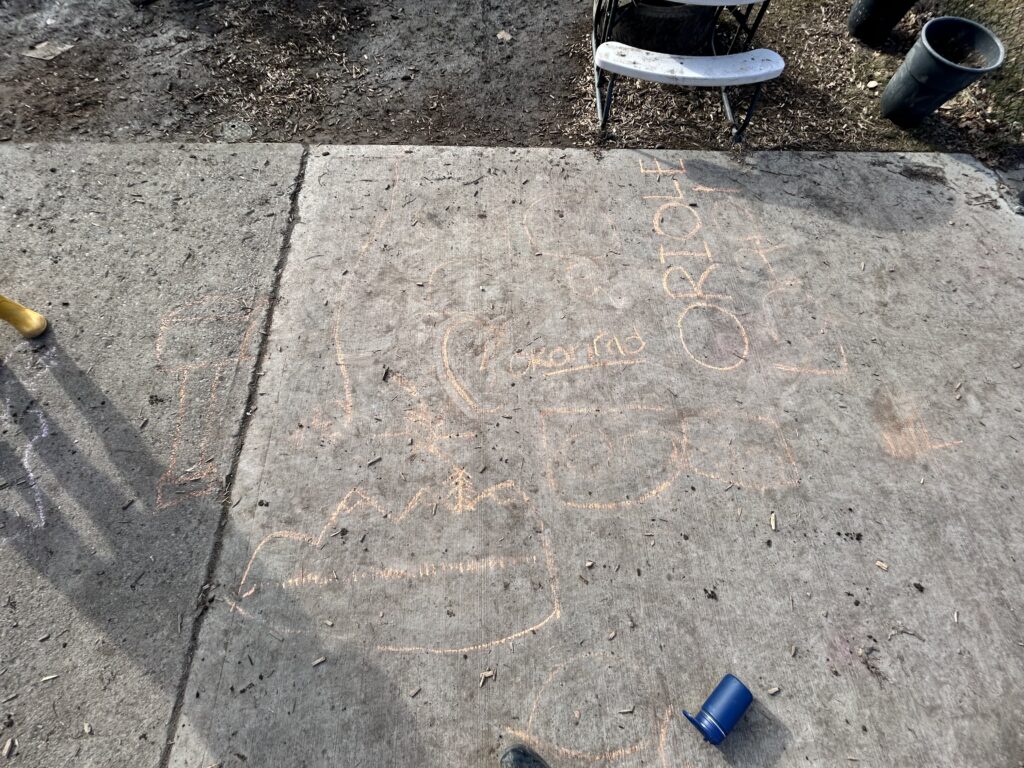
Going back outside we used chalk again. We noticed that chalk doesn’t just draw on the ground but on our cloths and skin to. A said “we can draw with chalk on us because it comes off, not like maker”. K “ya we can just wash it”. I said do you think our drawings will stay tomorrow? “Only if it doesn’t rain because chalk goes away with water”. We trued to chalk on many other surfaces seeing what it works best on. “It works on the playground to!” Said AM. “It’s really red in the ground but pink on here.” “I wonder why it’s different colours on different things I said” “cause this is slippery N said”. “Let’s draw what we see on everything!” This connects to our curriculum class lessons, where we learned how important it is to revisit ideas with children to help them expand their thinking. The BC Early Learning Framework (BC ELF) says that “children’s learning is deepened through opportunities to revisit ideas and extend their thinking” (British Columbia Ministry of Education, 2019). By giving the children time to explore their ideas more, we support their ability to think creatively and critically.
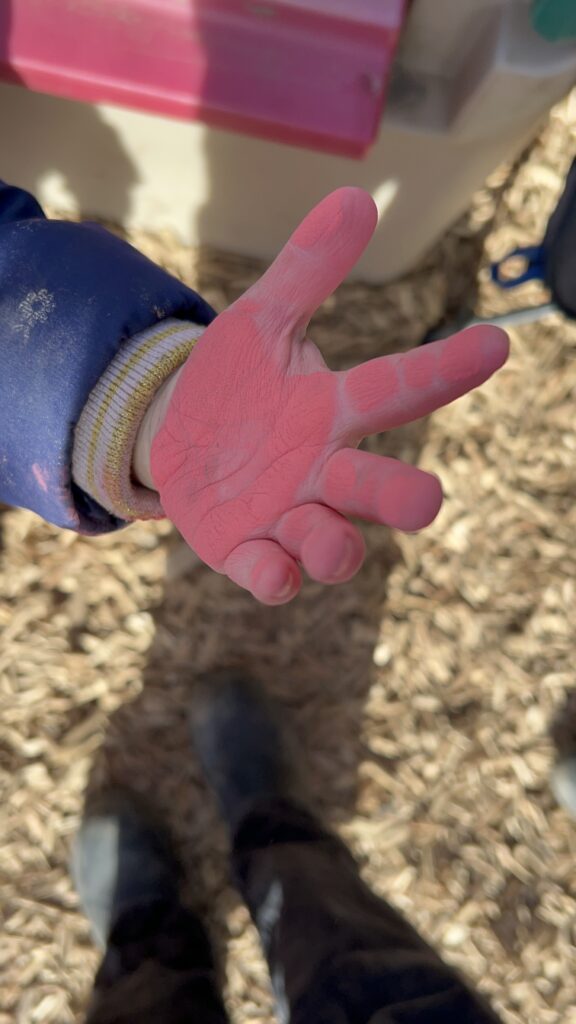
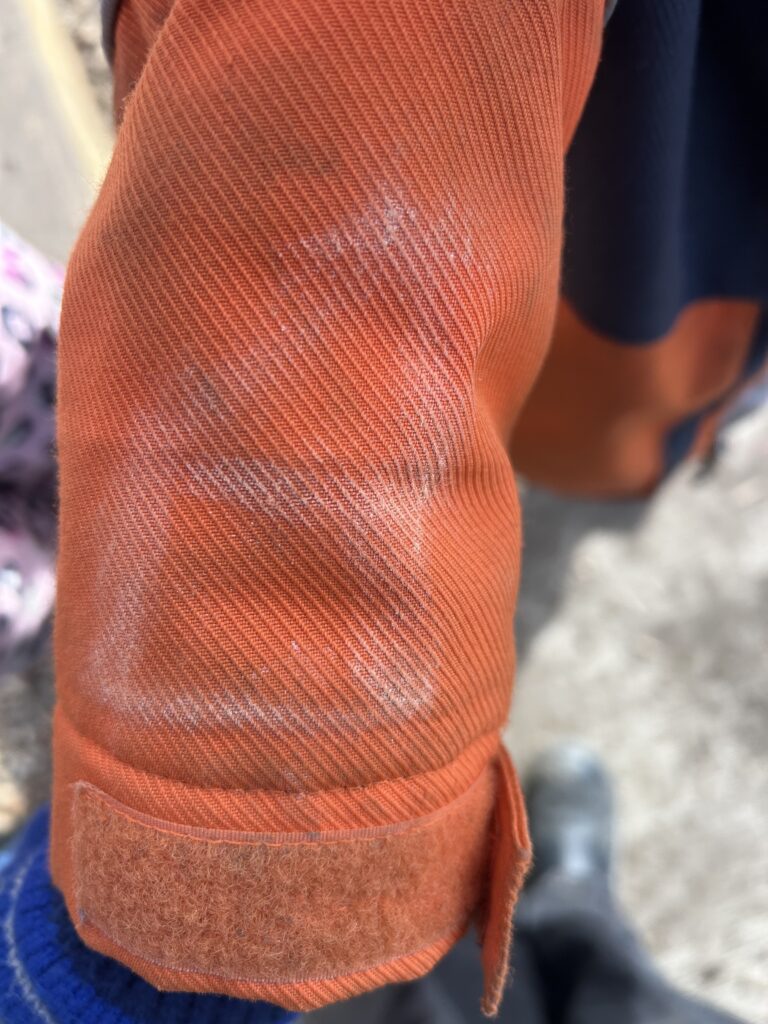
March 13th
Since it was raining we weren’t able to be outside for a bit so I took the initiative to take out a big price of paper to set out at a table. Some children came over and I showed them the chalk pictures that we drew the last week and how we were drawing what we saw. They wanted to recreate that by drawing the playground on the sheet of paper. We also found out that they will be getting a new play structure as well so they used their imaginations to show what a new play-structure could be like to play on:
A “I’m goona draw what I’m gonna draw when I was outside.
C “I’m draw the window”
A “this person fell off your climber and now has blood and goes to the hospital but if they don’t fall they can eat their cupcake outside if they want or sleep outside”
C “I like those climbers”
C “and I played pirates so I’m gonna do a pirate flag”
Am “we can even do the black top with the fence and the bikes we play”
“AND BIG WOOD CHIPS”
F “we are all doing it together what we did outside now” “ya everywhere on the paper”
E “I’m gonna put me and you and A on the slide and climbing”
E and if somebody falls off mine I put something at the bottom to catch them. Because one time E get hurt and don’t want that”
“LETS MAKE PEOPLE” and teaches”
Through this process, I saw how children can make connections between their experiences and use them to create new ideas, which is a key part of their development. Encouraging them to think back on their previous work and expand it helps foster a deeper understanding of the world around them.
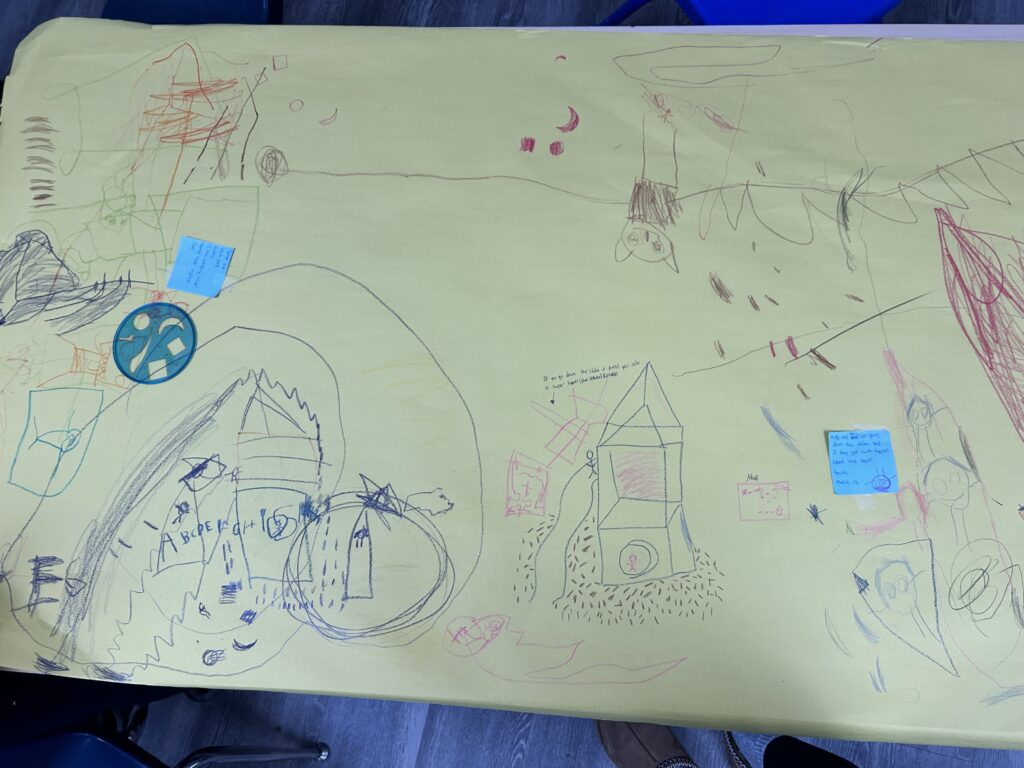
March 14th
This morning, I showed the children a photo of the park drawings we made when we were outside earlier. E remembered the cushion she added at the end of the slide to make sure no one got hurt. The children were excited to recreate their playground outside. They asked to go in the shed to gather supplies, and one child found big mats, starting to lay them at the end of the slide. “It’s just like my picture,” E said. “We can even make it a bigger slide,” said P. They laid out a trail of mats and started sliding down fast. “We’re sliding in like pirates, just like my picture too!” K exclaimed. “All into the water!” Before they knew it, it was time to go back inside. “Ms. Daneeta, can you take a picture like you did with our drawings so we can do it again and again?” asked A. “Of course I can, it’s important to remember our good ideas!”
This connects with the BC Early Learning Framework, which emphasizes that “children are encouraged to express their creativity and ideas through various forms of representation, including physical play and visual arts” (British Columbia Ministry of Education, 2019). The children’s enthusiasm in recreating their play scene and reflecting on it shows how meaningful and valuable these creative experiences are.
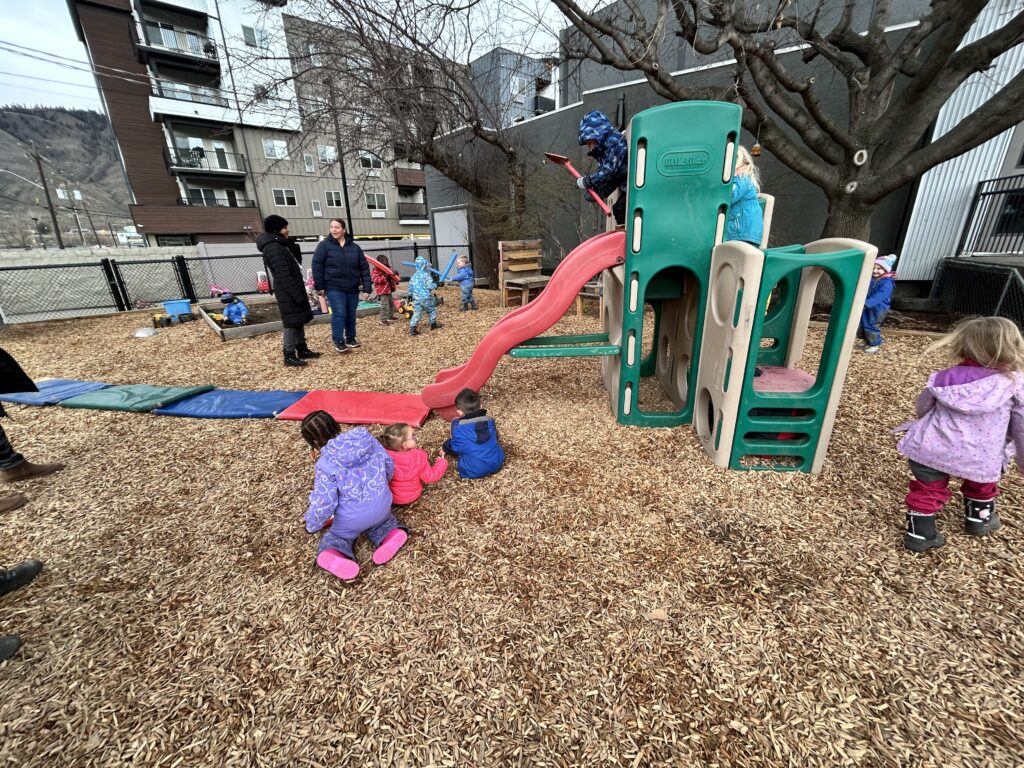
March 19
Today I was asked to be in the other room because they needed some extra help. I was in that room last practicum so I knew many of the children. I remembered that they love to play with the balance blacks and joined in on their play. We spoke about how we are going to set them up, why, how and if we feel comfortable balancing on them when they aren’t in stable spots. The children were so happy to see that I was involved and wanted me to keep balancing with them. That’s when E said “you have to play with us cause you’re a student and not a teacher”. I asked “what is the difference between me and a teacher” and she responded “students play with the kids and teachers do work”. This helped me see that the children aren’t used to the idea of other adults playing with them. I explained to them that yes I am a student but I’m learning to become a teacher and teachers like to play too. I told them that all the teachers also used to be students learning to become teachers and one day I will be called a teacher but I can still play with children. They understood a little but were just happy to see me play with them.
March 20
Today in practicum, I was able to use skills I learned in my guidance class to help two friends who were having a disagreement. One was upset because the other didn’t follow the rules. I first asked the upset friend how he felt, acknowledging his feelings. This helped him calm down. I then suggested that maybe the other friend didn’t know the rules. I asked, “What can we do to help our friend?” and he replied, “I can tell him my rules.” This is in line with the BC Early Learning Framework (BC ELF), which emphasizes “children’s abilities to communicate and understand each other’s feelings” (British Columbia Ministry of Education, 2019). I also used advice from Tuesday’s class about children wanting to sit beside me during snack time. I told them that I would sit with one of them at snack but would sit with someone else at lunch. This helped manage expectations and avoid disappointment. Throughout the day, I reminded them of this, which helped reduce their sadness later on. According to the BC ELF, “it is important to support children in understanding and respecting each other’s needs” (British Columbia Ministry of Education, 2019).
March 24
Today in practicum, we saw the beginning of the new part of the yard being built! It was really exciting to see construction happening right in front of us. To make the day even more special, I brought back the picture that the children and I drew of our old yard. We had fun drawing what the yard used to look like together, and I wanted to show them how much we’ve changed. When the kids saw the picture, they got excited and wanted to keep drawing what the new yard might look like. Some of them drew gardens, others added pets like dogs and cats, and a few even got creative with aliens and zombies! One child even drew a “standing dog,” which was really funny. The children also started drawing what they would want to play in the new yard. Some of them wanted to play tag, while others imagined being ninjas, jumping around and practicing cool moves. It was fun to see all their ideas and how excited they were to share what they hope the new yard will be like. Today was a great way for the kids to imagine and get involved in the changes happening around them!
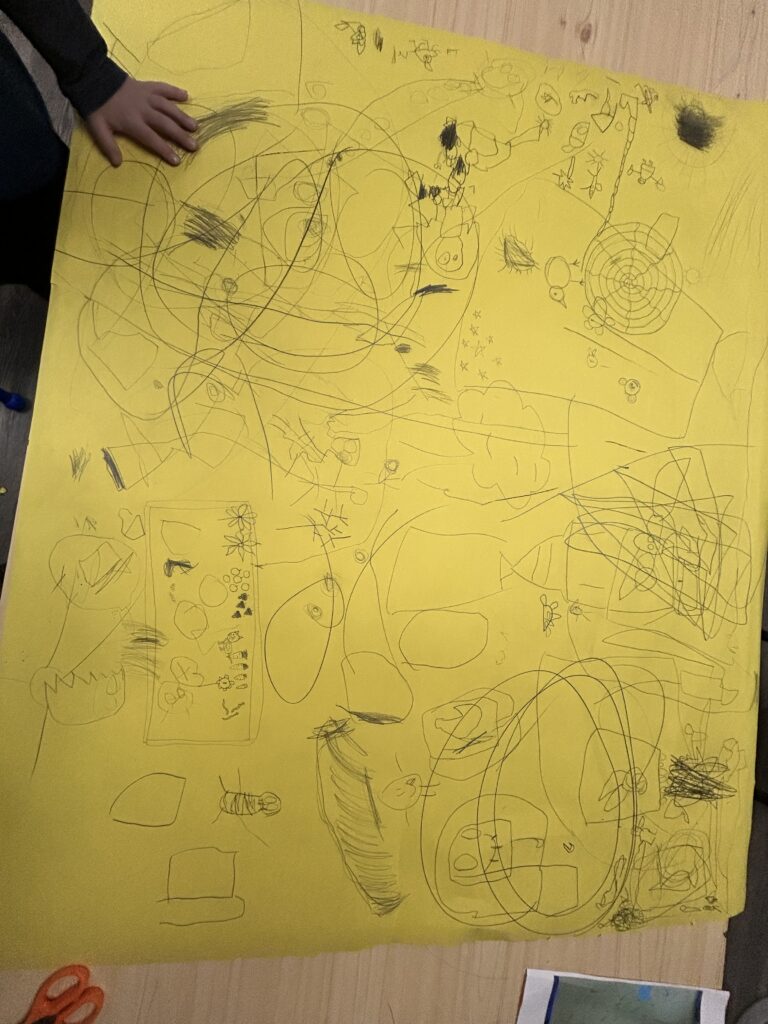
March 26
Today at practicum, we watched the workers continue to work on the yard. We were excited to see the changes they were making. Some of our ideas about what the yard would look like were different from what we saw. A few things we guessed were right, but some were wrong. Afterward, we went back inside and talked about what we had seen. Some of us still thought our ideas could be added to the yard, even if they weren’t there yet. One of the children said, “Miss Daneeta, maybe we can colour in our drawing to make it be more like the yard.” I brought out some colours, and we started to fill in our pictures. “Now it’s starting to be right! Almost like our yard,” one of them said. I also showed the children an old drawing we had done earlier. (This is something we learned about in curriculum class) Seeing the old drawing helped spark new ideas in the children. They began to think of other things that could be added to the yard, like new plants or swings. It was a fun way to learn, and we could see how our ideas had grown with the new things we saw happening outside!
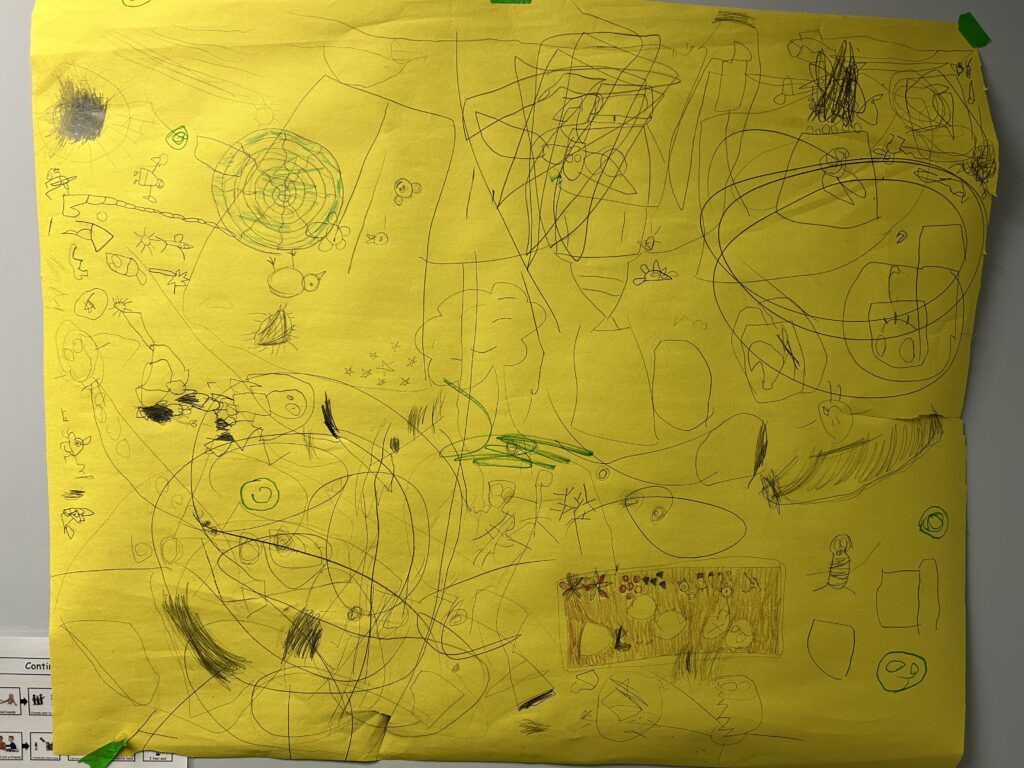
March 28th
Today, our class had an exciting adventure exploring the playground and discovering the tiny creatures that share our environment, especially worms. Some of us wondered if sticks could be worms or if they might have worms inside them. We observed that worms are slimy, long, and wiggly. After our outdoor exploration, we returned to the classroom and added drawings of worms and other bugs to our playground illustrations. Since it was also our first day playing in the new yard, we included the new teeter-totter and climbing wall in our drawings. There was some disagreement about what teeter-totters look like and how we could design our own versions. This led to a discussion about different interpretations and how we can collaborate to create a collective version of a teeter-totter.
Today reflected the ideas discussed by Sylvia Kind and Cindy Lee. They emphasize that drawing is a language that engages children in expressive, emotional, imaginative, and intellectual ways. It serves as an important cognitive and affective process, a rich means of storytelling, and a valuable way for young children to make sense of the world. Through drawing, we can express what cannot be adequately put into words.By observing worms, debating ideas, and expressing our thoughts through drawings, we are using art to explore. Kind and Lee (2017)

March 31
Right when I got to the yard in the morning the children said
“It’s raining! That means the worms should come out”
So we went to look for worms in the mud pit.
“We know they’re here because they live underground”. Do they only live in mud or could they be under the wood chips as well I asked?
“The wood chips are too dry” “ya worms only like us that’s why they come out in the rain.”
“We need to look really deep because they’re homes are down dupper far like really in the dirt.
“Do you think their families are down there too, I asked?”
“Actually one was at my grandma’s house.”
“No they weren’t”
“Well ya my grandma has mud and worms there too”.
“But that’s not their family because family should stay together.”
“Do we live with family like worms?”
“Ya cause we will miss our mom and they do too”
“LOOK WE FOUND A BABY”
“Now we need to find her mom too”………
April 2
We found three worms today! It wasn’t raining, but the ground was very wet and muddy, so we knew the worms would be out. The first one was on the pavement. “How did it get there?” I wondered. “It wiggled back and forth like this” said E
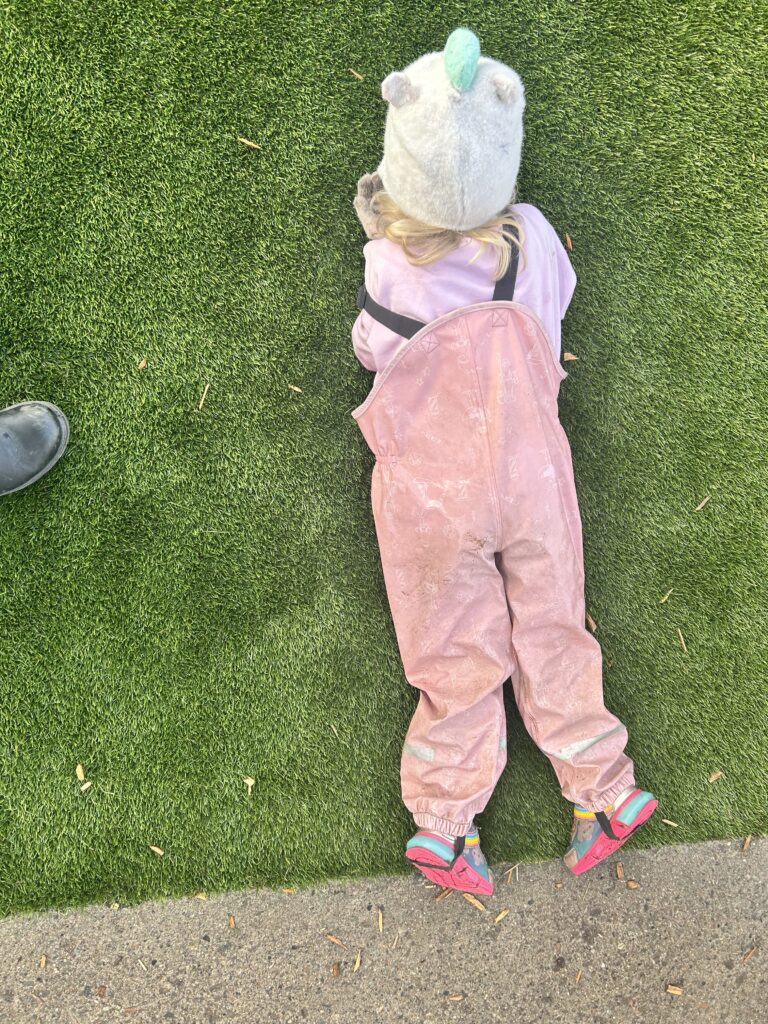
“Ohh, that’s how worms move! They don’t have legs, so they just wiggle.” We didn’t want the worm to dry out, so we grabbed a bucket from the shed. We filled it with mud and carefully placed the worm inside to keep it safe. Then, we decided to look for more worms. We searched the sandbox and found two more! They were small and wiggly, just like the first one. We gently picked them up and put them in the bucket with their new worm friend. Watching the worms move was so interesting. They stretched and squirmed through the mud, happy to be in a moist place.
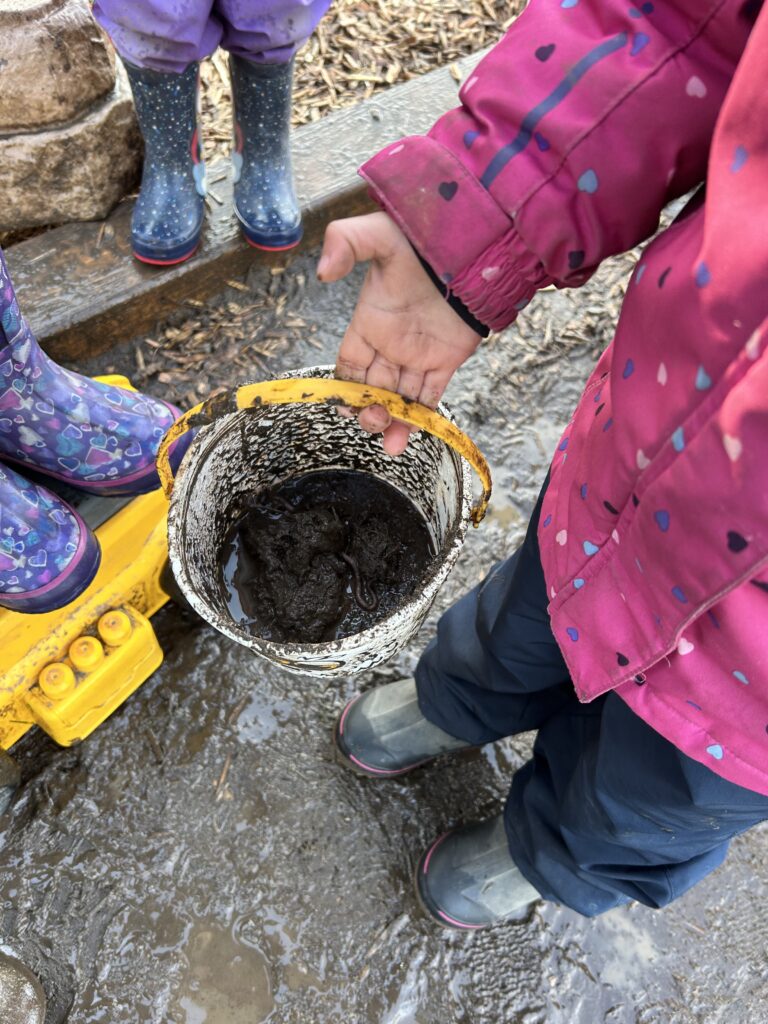
We used different tools to help us find worms. First, we used a shovel to dig into the dirt. The shovel helped us move the soil and get deep enough to find where the worms might be hiding. It made digging much easier than using our hands. Next, we used a rake to carefully search through the mud. The rake helped us spread out the dirt so we could look closely without making a mess. This made it easier to spot worms without hurting them. The most interesting tool we used was the magnatector. This special tool helped us detect where the worms were. Instead of just guessing, we could use the magnatector to know exactly where to look. It helped us save time and find worms faster.
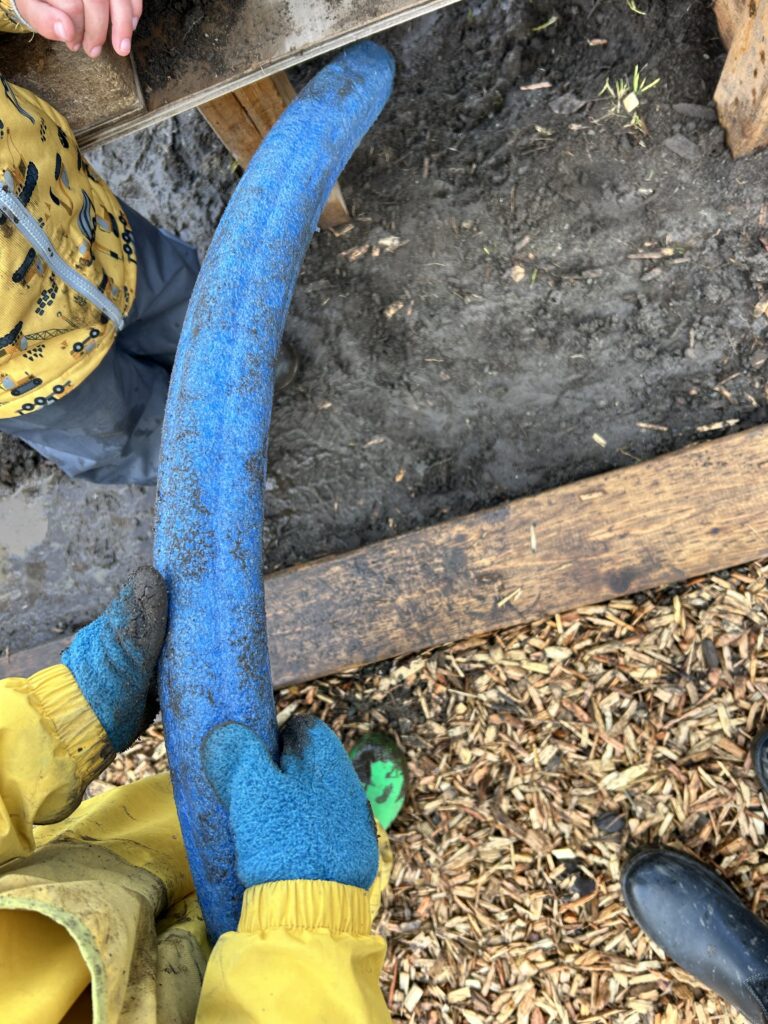
By using these tools together, we were able to dig, search, and detect worms much more easily than if we had only used our hands. Each tool had its own job, and they all worked together to help us find as many worms as possible. It was a fun and exciting way to explore the soil and learn more about the creatures living underground!
Resources
British Columbia Ministry of Education. (2019). *British Columbia early learning framework*. https://www2.gov.bc.ca/gov/content/education-training/early-learning
Early Childhood Educators of British Columbia. (2019). *ECEBC Code of Ethics*. https://www.ecebc.ca/
Kind, S., & Lee, C. (2017). Moon bear and the night butterfly: Exploring the pathways of children’s drawing-stories. In M. J. Binder & S. Kind (Eds.), *Drawing as language: Celebrating the work of Bob Steele* (pp. 101–116). Brill. citeturn0search0